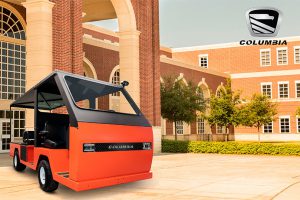
In a surprising twist, electric golf cars have emerged as a favored choice for many American families as their “secondary vehicles.”
Over the recent years, a remarkable vehicular trend has quietly gained momentum across the United States – the rise of electric vehicles. According to Electrek, these compact, efficient, and adaptable vehicles are no longer confined to country club settings. They are now a common sight in neighborhoods and are even being used for daily commutes. So, what’s driving this sudden surge in their popularity?
Primarily, credit must be given to the significant advancements in electric vehicle (EV) technology witnessed over the last decade. Unlike economic trends, innovations in electric car technology do indeed filter down to other applications.
Electric golf cars have harnessed the advantages of this technological revolution, transcending their role as mere golf course cruisers. Present-day models come equipped with enhanced battery life from compact lithium-ion batteries, increased power delivered by higher-quality brushless electric motors, and an impressive array of creature comforts. The desire for a lifted electric golf car with a sound system is no longer a customization task – these sophisticated cars are readily available from dealerships.
Modern electric golf cars now provide smooth, silent rides with ranges sufficient for convenient daily commutes. With no need for a gasoline engine, regular maintenance is unnecessary, eliminating the hassle of storing a fuel can in the garage. The issue of the car breaking down due to outdated lead acid batteries is also a thing of the past. Today’s electric golf cars offer a significant improvement, boasting top-quality lithium batteries and high-powered motors.
This convenience, combined with the increasing adoption of local ordinances permitting golf cars on smaller public roads, has allowed many families to consider replacing their second car with a golf car.
Several cities have embraced the legalization of golf cars as everyday vehicles, contributing to their convenience as car alternatives. Peachtree City in Georgia stands out with its numerous golf cars roaming the streets. The city’s logo even underwent a change, removing golf clubs to emphasize its identity as a “golf car city.”
Peachtree City not only permits golf cars on public roads but also provides multi-use paths for these vehicles, along with bikes and scooters, offering quicker routes and avoiding traffic from larger vehicles. While residents may still own a traditional car for longer journeys, they increasingly prefer to use golf cars for local transportation.
According to Ethan Luster, a golf car dealer owner in Clearwater, Florida, many customers moving to Florida prioritize these convenient vehicles as a standard form of local transport. For newcomers, buying a golf car is often one of their initial purchases before even seeing their new homes.
The affordability of electric golf cars is another factor propelling their popularity as secondary vehicles. Their prices are considerably lower than average cars, and their operating costs are a fraction of those for both gas-powered and electric cars. Reduced maintenance needs and minimal “fuel” costs make them an attractive option for budget-conscious consumers. A typical recharge can cost as little as one dollar and can be done in the owner’s garage, eliminating the need to visit a gas station.
While environmental concerns might not be the primary motivation for choosing an electric golf car over a second car, they are still a factor in their growing appeal. With increased awareness of climate change and the environmental impact of fossil fuels, many Americans seek greener alternatives. Electric golf cars align perfectly with this mindset, emitting no tailpipe emissions and possessing a smaller environmental footprint than conventional cars. Even issues like tire wear releasing harmful particles into the environment are minimized when using smaller and lighter vehicles like golf cars.
Yet, the attraction of electric golf cars transcends economic and environmental considerations. Their practicality in specific contexts is unmatched. For short trips within communities, such as visits to local stores, community centers, or friends’ houses, they are exceptionally convenient. Their compact size makes parking easy, and their speed of 20-25 mph is sufficient for residential areas.
Numerous communities, particularly retirement areas like Florida and Arizona, have already embraced golf cars, providing dedicated lanes and parking spots. However, it’s not just retirees enjoying these vehicles; families also find golf cars a fun and efficient way to manage school drop-offs, explore local parks, or simply enjoy a leisurely ride around the neighborhood.
Legal regulations have evolved to accommodate this trend. Many states now allow golf cars to be driven on public roads with speed limits of up to 35 mph, given they meet specific safety criteria. Manufacturers have adapted many models into Low Speed Vehicles (LSVs), a federally approved category allowing 25 mph vehicles meeting safety regulations to operate on roads with speeds up to 35 mph. These golf cars, conforming to regulations, don’t require special local ordinances for road use; federal guidelines, adopted by most states, already cover them. This regulatory support further enhances golf cars’ viability as secondary vehicles.
While safety might concern some due to golf cars lacking the protection of cars in accidents, when used appropriately—primarily for short, low-speed trips within communities—the risks are significantly reduced. Manufacturers are incorporating safety features like seat belts, mirrors, and efficient braking systems, all prerequisites for LSVs. As communities develop multi-use paths accessible to golf cars, these vehicles are further shielded from larger, potentially dangerous cars.
The rise of electric golf cars as secondary vehicles in the United States is a captivating convergence of technological progress, environmental awareness, economic prudence, and practical convenience. As this trend continues to flourish, it promises not only to reshape local commutes but also to usher in a greener, more sustainable future. These unassuming cars have traversed far beyond the golf course, securing a place in the hearts of American families.












